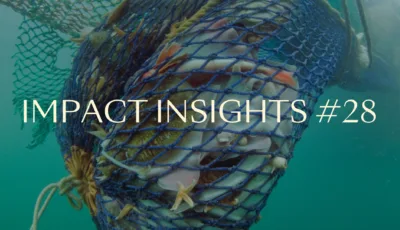Three dilemmas impact investors must navigate in 2025

As impact investing continues to grow, are we truly driving the change we seek – or are we caught in a web of complexity that dilutes our impact? With the latest global GIIN research estimating the market at nearly USD 1,6 trillion, growing expectations and requirements put impact investing to the test in 2025. These challenges call for a deeper reflection on navigating complexities without losing sight of the fundamental goal: creating tangible, lasting impact. Let’s explore three dilemmas at the top of the 2025 agenda.

1. Investing for impact or impact window-dressing?
Investors worldwide are increasingly recognizing the core definition and principles of impact investing. However, the growing number of frameworks and tools has created a range of impact investing practices, making it difficult to compare investments. While many initiatives exist to harmonize frameworks and tools, new practices emerge continuously as players in the space become increasingly sophisticated. Amidst the profusion, some players tend to continuously add new practices, building a complex web of processes and requirements around their impact investments. But is this really helping?
We should constantly consider how to refine and enhance our impact management. Evolving is a green flag. However, adding complexity without questioning its role in your setup can become a problem. There is a risk of creating an “impact bureaucracy beast,” draining resources and distracting you from your goals. A secondary effect is the offputting message it sends to all investors thinking about dipping their toes in impact investing: “Impact investing is complicated, and you need massive resources to do it right.”
The complexity potential is limitless, but adding more frameworks and tools doesn’t always lead to greater impact. The “more is more” approach can quickly turn into “impact window-dressing” (not to be conflated with impact washing)—a way of showing off numerous practices to prove sophistication rather than focusing on the actual change we want to create[1]. Examples of practices that have retained attention in the past year are third-party verification and impact-linked compensation. While these may be an excellent fit for some impact investors, they will certainly not produce additional effects for all strategies. We should not jump blindly on the bandwagon - Impact investing is not about integrating every tool or framework available - it’s about selecting those that will most effectively produce your desired results.
What can you do about it?
It’s time to KISS[2] impact investing! Focus on the fundamentals of impact investing and your impact goals. Ask yourself: What is the real change we want to create? What are the most direct and measurable ways we can achieve this? Then ask: Do all the pieces in our framework direct us toward that? Do they help us achieve them?
It’s healthy to regularly dissect your approach and framework, surgically exploring the purpose and efficiency of every element. It is very likely you can put something in the graveyard.
As impact investing continues to grow, are we truly driving the change we seek – or are we caught in a web of complexity that dilutes our impact
2. Sustainability: Strategic imperative or compliance exercise?
As sustainability regulations continue to overwhelm companies and investors throughout Europe, we face a critical question: Will we turn it into a strategic opportunity or another compliance task? These regulations are vital for transparency and building the groundwork for a more sustainable future. However, focusing too much on them can take resources away from the bigger mission to drive tangible change.
The market expected 2024 to be a year of “implementation and streamlining” of the EU sustainable finance framework; instead, uncertainty and overwhelm seem to have grown. The EU recognizes the regulatory burden, and Commission President Ursula von der Leyen recently stated in a World Economic Forum address that the “unnecessary red tape” can hold back investments in the EU. In 2025, we cannot afford to get lost in compliance.
Brussels is now considering ways to simplify and alleviate the reporting burden from the regulatory tsunami. The EU’s upcoming Omnibus proposal aims to simplify, combine, and streamline requirements in the various sustainability-related regulations, contributing to the Commission’s goal of cutting reporting burdens by 25%[3]. Meanwhile, although the EU's push to simplify reporting is welcome, the challenge is ensuring that it doesn’t end up stripping them of their most impactful provisions.
You can make compliance a means to an end—not the end itself.
What can you do about it?
It’s easy to get caught in the compliance trap. But here’s the thing: sustainability is not about meeting requirements—it’s about setting a direction for long-term value creation. Regulations are fast-changing: what’s required today may not be tomorrow, so don’t let them dictate your sustainability strategy. Instead, be proactive. Use regulation as a way to get your organization up to speed on sustainability and deepen the commitment to change. On all the aspects that just “need to get done,” do what you must and leave it at that. This way, you can make compliance a means to an end—not the end itself.
3. Monetizing impact: A necessary trade-off or a step too far?
The impact investing community faces a divide: Some believe everything should be quantified in a monetary value[4], while others believe that preserved nature, a healthy climate, and people's well-being have an inherent value that cannot be fairly captured in financial terms. New impact accounting and valuation frameworks aim to align impact with traditional financial language, making it easier to compare investments.
Monetizing impact can feel like the easy way out—an approach that fits neatly into the familiar language of returns, risks, and valuations. However this approach risks oversimplifying complex issues and reducing impact to a transactional value. Not all impacts are created equal; true impact requires context and nuance—elements we can’t always capture in a financial statement. A framework that works for one investment may not work for another. For example, an initiative that reduces carbon emissions in one region may have a radically different impact in another, depending on local challenges and needs. It’s essential to acknowledge that monetizing impact can oversimplify complex issues.
For impact to be taken seriously in its own right, the financial industry needs to be educated in reading and interpreting impact metrics. This can’t be done overnight, and, meanwhile, the question remains: How do we convey the tangible impact results to stakeholders?
What can you do about it?
To address this challenge, make a conscious choice that aligns with your organization’s values, goals, and stakeholder needs. Consider the trade-offs of expressing impact in monetary terms—does it simplify communication or risk losing essential context? Regardless of your stance, striking a balance in your narrative is likely beneficial. For example, you can provide the quantitative impact valuation to communicate the big picture to traditional financial stakeholders while providing them with the richer, qualitative context and nuances—the story[5]. In any case, clarity on underlying assumptions and trade-offs is key.
Navigating 2025: Clarity Over Complexity
Impact investing is at a crossroads. The choices we make in 2025 will determine whether we drive real change—or get tangled in complexity, compliance, and misleading metrics. The dilemmas we face are not just theoretical; they shape how we measure success in impact investing and will lay the foundation for how it’s practiced and perceived over the next crucial decades for the future of humanity.
So, let’s stay focused on the fundamentals. Challenge complexity when it doesn’t serve impact. Push back against sustainability as a box-ticking exercise. And make sure the way we communicate impact strengthens—rather than dilutes—the reason we are in this space in the first place.
What will you choose to leave behind in 2025?
Footnotes
[1] Impact window-dressing does not necessarily mean that intentions are dishonest, but it often entails mistaking framework sophistication for impact outcomes.
[2] “Keep it simple, stupid” (KISS) is a design principle that advocates for simplicity in systems, communications, and problem-solving. Originating in the U.S. Navy in the 1960s, it’s a guiding philosophy we embrace at Norselab. We believe that by becoming true experts in our field, we can cut through complexity, focusing on what truly matters, bringing simplicity and clarity.
[3] 25% for enterprises, 35% for SMEs, according to the newly released the Competitiveness Compass
[4] Suggested resources on impact valuation: Monetising impact (Impact Europe), Impact-weighted Accounts Framework, Multiple of Money, Net impact sum (Upright Project).
[5] To discover how we at Norselab did this, consult our Meaningfulness Report.
Suggested resources on impact valuation:
Impact-weighted Accounts Framework: https://impacteconomyfoundation.org/impactweightedaccountsframework
Multiple of Money: https://hbr.org/2019/01/calculating-the-value-of-impact-investing
Net impact sum: https://docs.uprightplatform.com/metrics/net-impact
Impact Rate of Return


